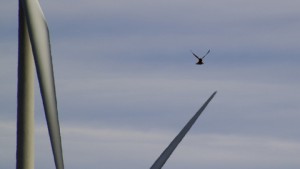
Image credit Clean Technica
Wind turbines are supposed to be good for the environment. That’s the point, after all; by harnessing a natural, limitless resource, we can cut down on pollution and save the Earth’s forests for future generations. But despite the good intentions, there’s one unexpected side effect to the local ecosystem: the danger to birds.
Unexpected Collisions
Aside from the occasional airplane, birds are the undisputed masters of the skies. They fly unimpeded across long distances, travelling at fairly ridiculous speeds without worrying about traffic congestion or road blocks. Or at least, they did, until we decided to fill the sky with turbines.
The average turbine is about 140 feet high. For reference, that’s 14 standard basketball hoops stacked on top of each other, or a 10-14 story building. Each of these turbines has rotating blades, which can reach speeds of over 170 miles per hour. However, the scale of these turbines makes those blades look like they’re rotating fairly slow.
Now imagine you’re an eagle, flying through a wind farm. You see an opening, glide on through, only to have one of those blades clip your wing. Eagle, human, or elephant, anything going 170 mph is going to hurt, and cause a serious injury.
An estimated 570,000 birds are killed by turbines in the US each year, either by colliding head-on with a blade or simply getting blown off course. Some birds perch on the top of a turbine while the blades are still, and get to enjoy a deadly ride when that breeze pick up again.
Granted, collision injuries and deaths are nothing new to avians. Far more birds fall victim to an impact with a glass window in an office building. Still, this unintended impact on the environment is definitely something the industry is hoping to minimize.
Saving Birds Through Turbine Design
A surprisingly easy way to cut down on bird casualties is to switch to a vertical axis wind turbine. VAWTs are easier to avoid; imagine flying past a barber shop pole, versus flying around a giant fan. They are also far more difficult to perch on; even if a bird does decide to sit on the top, it isn’t in line of any whirring blades.
If that won’t work, you can try installing a sound system, much like those used by gardeners. Avian distress calls and unnatural noises will help birds vacate the area, and keep them away from the dangerous turbines. You can also find a way to make the turbines shiny; reflected light has a similar effect.
Another suggestion is to make the turbines more visible. An Energy Norway project dubbed INTACT is testing out the effect of brightly colored blades. White tends to blend in against clouds and the light blue sky. Black, bright green, or even red would be far easier for birds to register – although it might not be as appealing to the human eye. But for the sake of saving countless feathered lives, a few eyesores might be worth it.

Comments are closed